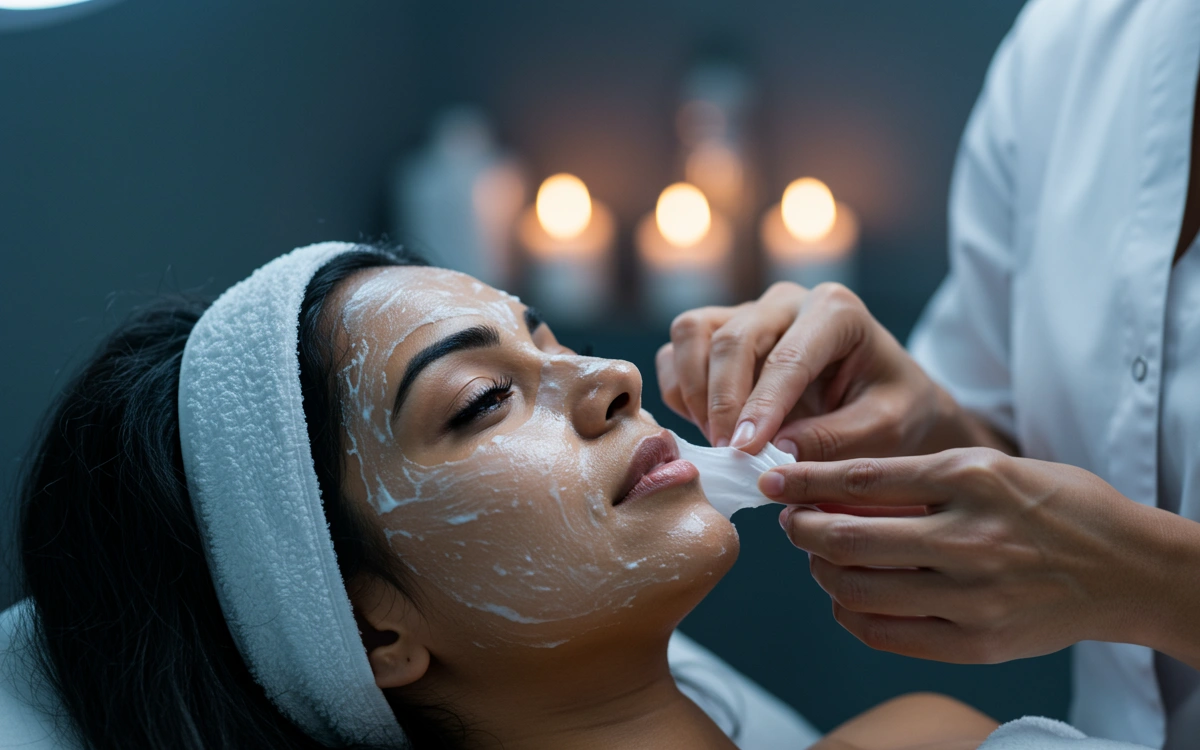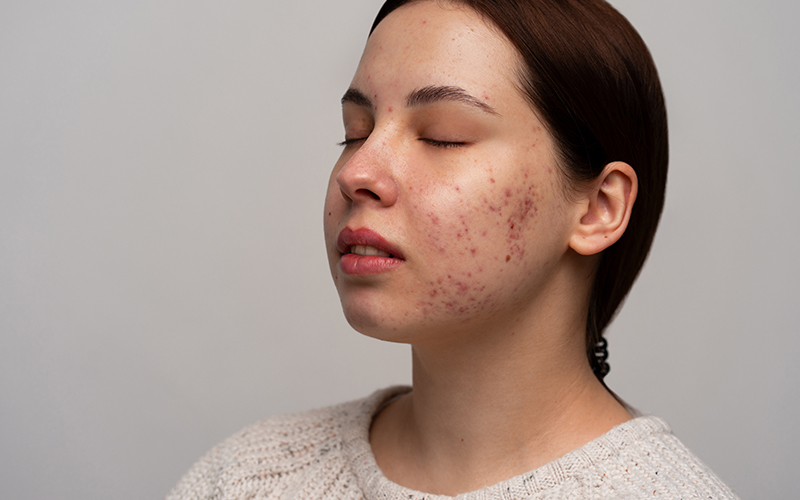Chemical peels are a multipurpose skincare procedure that may be used to treat wrinkles, pigmentation, acne, and other skin issues. Each form of chemical peel has distinct advantages, and you may select from a variety of peels based on your skin type, problems, and desired outcomes.
Depending on your skin conditions, you may tailor this therapy. Any area of your face can be treated with this cosmetic procedure, such as:
Full Face
- Enhances overall skin clarity, tone, and texture.
- Targets pigmentation issues, wrinkles, and fine lines on the forehead and temples.
- Hyperpigmentation scars from acne
- Uneven skin tone or redness due to melasma
Cheeks
- Treats sun damage, acne scars, and uneven skin tone.
Nose
- Reduces blackheads, minimizes pores, and improves skin imperfections.
Chin
- Smooths rough skin and reduces discoloration.
Eyes (with mild, specialized solutions)
- Lightens dark circles.
- Softens fine lines and wrinkles.
- Upper Lip: To balance out the pigmentation and smooth out creases.
Chemical peel treatments are used to treat a variety of skin conditions or to enhance the tone and texture of the skin. They are also frequently used to the hand, neck, and face to treat ailments such as sun damage, wrinkles, and fine lines.
Types of Chemical peel skin treatment
Chemical peels are a versatile skincare treatment for wrinkles, pigmentation, acne, and more. Different peels offer unique benefits, and you can choose one based on your skin type and goals.
This guide outlines the procedure, ideal skin types, treatment time, and number of sessions needed.
1. Superficial (Light) Chemical Peel
A superficial (light) chemical peel uses mild acids like glycolic, lactic, or salicylic acid to gently remove the outer skin layer. It helps even skin tone, brighten dull skin, reduce mild acne, and improve texture with minimal downtime. The 15–30 minute procedure may cause redness and peeling for 1–3 days. Suitable for all skin types, it works best for dry, acne-prone, or mildly pigmented skin. Regular sessions (every 2–4 weeks) maintain results. After treatment, sunscreen and hydration are essential to protect the newly exposed skin.
2. Medium chemical peel
A mild chemical peel penetrates the epidermis and upper dermis to improve texture and boost collagen production. It helps reduce hyperpigmentation, UV damage, acne scars, and fine wrinkles. A higher concentration of glycolic acid or trichloroacetic acid (TCA) allows for deeper exfoliation than a superficial peel.
During the about 30- to 45-minute treatment, patients may feel a burning or stinging sensation. Recovery takes five to seven days, during which time flaking, peeling, and redness are noticeable. The complexion may become smoother and more even if the skin darkens before peeling. Using sunscreen after treatment is essential to avoiding problems.
3. Deep chemical peel
An intense skin treatment called a deep chemical peel targets deep acne scars, severe wrinkles, and substantial sun damage. Strong acids like phenol or high-concentration TCA penetrate the lower dermis, boosting collagen production and revealing smoother skin. Because of its severity, the treatment may require anesthesia and takes one to two hours. Up to three weeks of severe redness, swelling, and peeling are typical during recovery, and the sensitivity may persist for months. Thorough post-treatment care is crucial, encompassing sun protection and moisturizing. Despite their long-lasting effects, deep peels are often only done once because of their strength.
Chemical peel treatments: what are they?
Chemical peel treatments target certain skin layers with chemicals. However, depending on your skin type, concerns, and general health, chemical peeling may not be the best option for you. What you should know is as follows:
1. Exfoliates Dead Skin
The outermost layer of dead skin cells is removed during chemical peels. This facilitates the removal of tough, lifeless skin to make room for fresh, healthy skin. Frequent exfoliation with chemical peels maintains the skin’s youthful appearance.
2. Brightens Skin Tone
In order to improve radiance and lessen dullness, chemical peels speed up the skin’s natural cell turnover process. A more radiant complexion is the result of their efficient fading of uneven pigmentation, sun damage, and dark spots.
3. Reduces Acne & Scars
Salicylic acid-based chemical peels unclog pores by removing dead skin cells, bacteria, and excess oil. They help fade acne scars, prevent future breakouts, and reduce active acne
4. Minimizes Wrinkles & Fine Lines
Enlarged pores and uneven texture can affect your skin’s appearance. Laser resurfacing removes damaged outer layers, promoting new, healthy skin cell growth. This improves texture, minimizes pores, and leaves your skin smoother and more radiant.
5. Improves Skin Texture
Chemical peels boost collagen production, improving skin elasticity and reducing wrinkles. Medium and deep peels provide lasting results, reducing deep wrinkles and visible signs of aging.
5. Non-Invasive & Customizable
Chemical peels adapt to various skin types and concerns, offering tailored treatments from mild to deep.
What Happens During and After the Procedure
1. During the Procedure
- Washing the Skin
To guarantee that the chemical solution can permeate the skin, it is carefully washed to get rid of makeup, oil, and debris.
- Using the Chemical Solution
A brush, cotton pad, or sponge is used to gently apply the selected peeling agent—such as phenol, glycolic acid, salicylic acid, or trichloroacetic acid—to the skin. The depth of penetration depends on the chemical peel’s strength and kind.
- Tingling or Burning Feeling
The solution may cause a mild to moderate burning, stinging, or tingling feeling on the skin. To reduce pain, use a fan or cool compress.
- Neutralization, if necessary
Glycolic acid peels, for example, need a neutralizing solution to halt their chemical activity, whereas salicylic acid peels gradually self-neutralize.
- Finalization and Hydration
If necessary, the peel is removed once the allotted amount of time has passed, and the skin is then protected with a calming moisturizer and sunscreen.
2. After the Procedure
- Instant Sensitivity and Redness
The skin may feel tight or sensitive, and it may seem a little red or flushed, like a minor sunburn.
- Deterioration and Flaking
The skin may begin peeling in two to three days and continue to do so for up to a week, depending on the kind of peel. Deeper peels result in more noticeable peeling, whereas superficial peels generate minor flaking.
- Restorative and Regenerative
Newer skin that is smoother and brighter appears when the old skin sheds. This procedure encourages a youthful glow, reduces pigmentation, and enhances skin texture.
- Strict Sun Defense
Applying broad-spectrum sunscreen is crucial to preventing sun damage and hyperpigmentation since the skin becomes more vulnerable to UV rays following a peel.
- Hydration and Recovery
Keeping the skin hydrated promotes healing and lessens irritation. Exfoliants and retinoids are examples of harsh skincare treatments that should be avoided until the skin has fully recovered.
Result of Chemical Peels
The effects of chemical peels vary based on their depth. Right after treatment, skin appears smoother and more radiant, though mild redness and peeling may occur. Within weeks, benefits include fewer acne breakouts, reduced pigmentation, and softer fine lines. Long-term results show improved tone, texture, and a significant reduction in wrinkles and acne scars. While medium and deep peels offer lasting results, superficial peels provide short-term improvements. To maintain lasting results, regular sun protection and proper skincare are key to preserving youthful, glowing skin.





